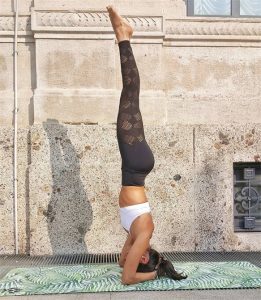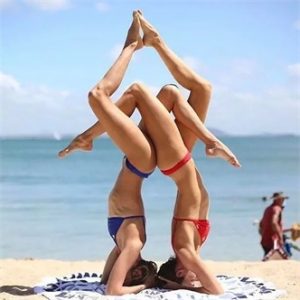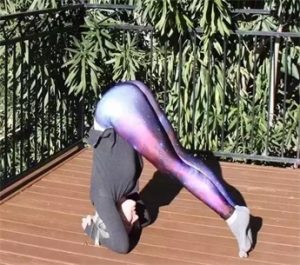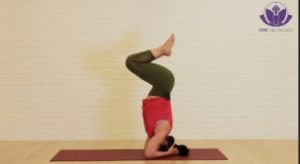- Home
- Asanalysis
- How to do a handstand
How to do a handstand
by Amos LeePost On:2020-04-29
After reading this article, perhaps you will realize the grand goal of handstand.
The top of the head and the feet on the ground are the normal standing or walking modes of human beings, so when we need to turn our bodies upside down, we instinctively feel resistance and fear, which also creates the stereotype that handstand is difficult. Our ancestors told us that nothing is difficult in the world, as long as we are willing to admit the unintelligent, bah, as long as we are willing to study.
Let’s first analyze the handstand pose. The foundation of head handstand is triangle formed by elbow and head. When elbow and head take root downward, stable shoulder joint and strong shoulder and back strength are required. The process of feet off the ground requires certain core strength and the ability of hip joint to rotate flexibly. When we are in stable balance in the air, we need our legs to be strong inside and outside and our foundation to be stable down.
Having said so much is to tell you that if you want to do head handstand, you need a strong core, strong thighs and strong shoulders and backs. Seeing this, many girls will give up. Don’t worry, maybe you are more powerful than you think. Especially with a little skill, head handstand is not completely hopeless.
A good start is half the battle. If you enter the pose correctly, you will be a big step closer to handstand.
First of all, carry out psychological construction before you do it. Fear is your biggest obstacle. If from the beginning of preparation, your mind is the sound of “break down, be afraid of fear”, then goodbye and try again next time.
Secondly, it is very important to find a good position. The distance from kneeling on four feet to holding elbows with both hands is the position of elbows, so don’t slide. Once the distance is wider than this position, it is difficult for shoulders to exert force, that is to say, the foundation is too weak, and it is impossible to think of it.
Hold your occipital bone with your fingers clasped, not your head, not your neck, but your occipital bone, and remember to hide your little thumb, otherwise you will hurt yourself. The position where the head contacts the ground is the position of the Baihui acupoint on the top of the head, not the forehead. Relax your neck. If you can’t turn your neck left and right, please adjust it again, otherwise the danger index will be too high. There is only one neck. Please cherish it!
Why can’t I stand on my head? Once you have prepared and laid the foundation, you can begin to move forward. The goal is to push the hip directly above the foundation, i.e. to make the sacrum-upper back-back of the head in a straight line perpendicular to the ground. Many people will be stuck in this step. Please take a look at the situation below and see which one you are.
The first is that the elbows of both hands cannot be pressed on the cushion, which is more common in men, because the triceps, intercostal muscles and serratus anterior muscles are relatively tense, causing the shoulders to fail to open.
Secondly, the feet cannot reach the position where the hip is placed above the foundation, which may be caused by weak strength in the core area or excessive tension in the entire fascia dorsal line or thigh adduction muscle weakness.
The third one is to lift your feet under the illusion of tightening your abdomen. Many people heard that the head upside down uses the core strength. In the preparation stage, you will close your abdomen tightly, hold your breath, and then give up when you are tired and sweating. When you stand upside down, your belly will make your ribs protrude outward, which will make your torso unable to stand upright directly above the foundation, thus losing stability. The fourth is not hip rotation. After the hip joint is placed above the foundation, tilting the pelvis forward slightly will automatically lift the feet off the ground, and then slowly turn the pelvis forward and back to the upright position during the leg lifting process. However, if the hip joint is not flexible enough, it cannot be flexibly adjusted to help stabilize itself during this process.
How to take advantage of your body to enter the headstand. It is very important to know your short board, but if you know that you can make good use of your strong points, you also have skills to help you do handstands. For example, if your shoulder strength is strong and your flexibility is poor, your hip cannot be placed above the foundation when your foot is not far away. It doesn’t matter.
Let the foundation exert downward force and lean forward on your pelvis can still drive your legs upward. For example, your flexibility is very good and your core strength is not enough. You can try to lift one leg first and lift the other leg with the backward force of one leg. You can also choose to separate your legs laterally, then lean your pelvis forward and lift the pelvic floor muscles, so that your legs can slowly leave the ground and then slowly approach your legs.
If you find your short board is too short and your long board is not long enough, then it is not like handstand, and it is not always the case.
First of all, you can choose to lower the steps in a body style. It is too difficult to do a complete handstand. Then you can bend your knees and feet off the ground. Here you can build a solid foundation.
Secondly, find help from the wall, do it against the wall, and help yourself to go up. during the practice against the wall, summarize which part of yourself depends on the wall, and then practice in a targeted way. however, note that here, the crack in the wall indicates that you are not recommended to kick and practice against the wall, because the process of jumping against the wall directly skips the foundation establishment, which will not help you in your later practice, and will also make you form a bad habit of exerting force, and it is difficult to leave once you rely on the wall.
Thirdly, you can practice dog, locust and dolphin more often to help you build up the strength of rotator cuff muscles, lay a good foundation and accumulate thick hair and thin hair.
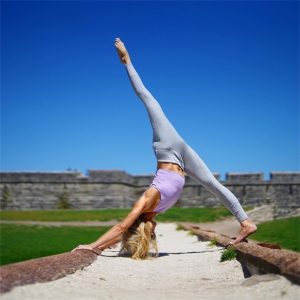
I went up, but I couldn’t hold on. What should I do?
No matter how you go up, it takes only one second to get down. Only then will you realize that handstand is not a force posture, but a balance posture. Ha, ha, ha, ha, ha, is there a feeling of being cheated? Don’t worry, this will tell you how to stabilize on it.
First of all, you should have a stable and sensitive shoulder blade. When the elbow is used as the foundation, it is our shoulder blade that provides continuous support for the body. When the elbow is pressed down, the shoulder blade stably receives the power from the elbow and sends it to the trunk for support through upper swing. Usually, you should do more lifting the arm or put more consciousness on the shoulder blade to enhance your awareness of it, so that you can mobilize it to work at any time when it needs continuous power.
Secondly, learning to close the root lock can help us stabilize the pelvis. A stable middle part of the body will improve your stability.
Finally, the legs are clamped to each other to enhance the stability of the anterior deep line of our entire fascia, stabilizing the middle core of the body from the inside out and avoiding swaying.
Click on the video to watch Doris’s demonstration and explanation, and also to see a variety of quick get handstand techniques:
Category
- Announcement (2)
- Asanalysis (1)
- Yoga knowledge (3)
Hot News

24/7 service hotline
Suggested email
contact address


